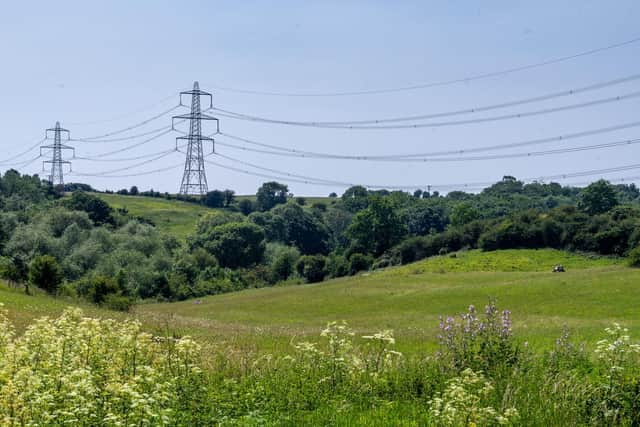The green belt in places like Bradford district is under 'extreme and sustained pressure', says countryside charity CPRE
The annual State of Greenbelt 2021 report by CPRE that there are currently 257,944 homes proposed to be built on land removed from the green belt – nearly five times as many as in 2013.
And the report identifies Bradford as one of the areas of the country where there is not enough previously used brownfield land available to meet the district's housing targets, meaning civic leaders will have to consider building on the green belt.


Advertisement
Hide AdAdvertisement
Hide AdThe Labour-run council in Bradford says its local plan allows for development in the green belt in less than two per cent of the district and in very limited ‘exceptional circumstances’.
The green belt - described by the CPRE as the 'countryside next door' - is a policy and land use zone designation used in planning to retain areas of largely undeveloped, wild, or agricultural land surrounding or neighboring urban areas.
The 257,944 homes currently planned on land that is to be removed from the green belt is lower than the 266,089 identified in 2019 but does not include a number of areas where local plans have been withdrawn.
A new poll, conducted by Opinium on behalf of CPRE, shows a surge in appreciation for local green spaces since the first lockdown, many of which are located in green belt areas. It found that more than two-thirds of adults think protecting and enhancing green spaces should be a higher priority after lockdown.
Advertisement
Hide AdAdvertisement
Hide AdBut the charity warned that the pressure to build on these areas is only set to increase under changes to the planning system currently being considered by the Government.
A government spokesman said this claim was "wrong", adding that protecting the green belt "is a priority and our national planning policy reinforces regenerating brownfield sites and prioritising urban areas".
Crispin Truman, chief executive of CPRE, said: "Local countryside and green spaces have been a lifeline through lockdown. Our poll shows massive public support for protecting these places - their importance for our mental health and wellbeing is undeniable.
"So, to see the growing level of threat faced by the green belt, the countryside next door for millions of people living in our towns and cities, is extremely worrying.
Advertisement
Hide AdAdvertisement
Hide Ad"The government can and must act to stop the loss of green belt and ensure greater access to nature and green space is at the heart of our planning system. This can be done by making best use of land that’s been built on previously before even considering development on the green belt.
"The public is crying out for more access to nature, green space and countryside – it’s time ministers realised this and put people and nature at the heart of their changes to the planning system."
The Government - which has a target of building 300,000 homes a year - revised its planning formula for calculating housing need in December so that more homes would be built in major cities in the North and Midlands.
It came a huge backlash from Conservative MPs regarding plans for the formula – dubbed a “mutant algorithm” – which would have focused housing in high value and rural areas in the South East.
Advertisement
Hide AdAdvertisement
Hide AdThe new algorithm proposes a cities and urban centres uplift, whereby 20 of England’s largest urban areas will have their housing targets increased by 35 per cent.
The CPRE says in Bradford - where nearly two-thirds of the district is green belt - the brownfield land capacity in the district is 10,716 but that with uplift the five-year target will be 11,500 homes, meaning it is hundreds of homes short.
Bradford's draft Local Plan document distributes new housing allocations between council wards and identifies greenfield and brownfield sites that are suitable for development before 2038.
The current housing target is for 1,700 new units to be built each year - a reduction on the pre-2019 figure of 2,476 - but 20 per cent of this number can be built on the Green Belt.
Advertisement
Hide AdAdvertisement
Hide AdIn the spa town of Ilkley, two sites have been put forward - Ben Rhydding Drive/Wheatley Grove (130 units) and pasture land off Coutances Way in Ben Rhydding, which could accommodate 155 new homes. The latter is owned by Bradford Council.
A Bradford council spokesman, said: “We are currently seeking views on our draft local plan which has a strong urban regeneration focus and is designed to meet the future demand for jobs and homes across our district.
“The current 23,500 hectares of green belt was established 15 years ago and represents around 64 per cent of the district’s area.
“The proposed new green belt allocations are for very limited ‘exceptional circumstances’ only development and represent just under two per cent of the district.
Advertisement
Hide AdAdvertisement
Hide Ad“Since 2005 we have built over 70 per cent of all new housing on brownfield sites and prioritised the use of non-green belt land.
“The council values our beautiful green spaces which gives the district its unique character and the new allocations are considered to be sustainable.
“The proposed local plan continues to emphasise the importance of redeveloping brownfield and non-greenbelt sites into high quality urban areas whilst protecting our valuable local green spaces.”
A Government spokeswoman said: “Our reforms to the planning system will protect our cherished countryside and green spaces as well as deliver high-quality and sustainable homes.
“Green Belt decisions will remain with councils and communities, ensuring they have influence over development, location and design.”
Comment Guidelines
National World encourages reader discussion on our stories. User feedback, insights and back-and-forth exchanges add a rich layer of context to reporting. Please review our Community Guidelines before commenting.